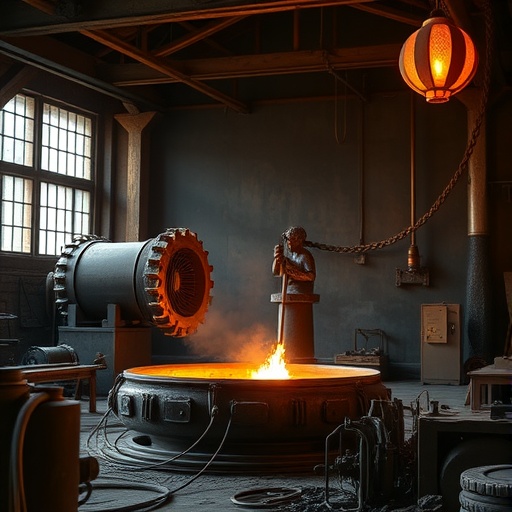In a groundbreaking study published in the journal Archaeological and Anthropological Sciences, researchers Zhou, Hong, Zuo, and their colleagues shed new light on the intricate relationship between bronze production and lead resource circulation within the context of the Yuhuangmiao Culture during the Eastern Zhou dynasty. This scholarly work brings forth significant insights into ancient metallurgical practices and the socio-economic implications of resource management in a historically rich period of Chinese civilization.
The Eastern Zhou dynasty, existing from approximately 770 to 256 BCE, was characterized by profound cultural and technological advancements. Among these advancements, metallurgy played a crucial role, particularly in the production of bronze tools, weapons, and ceremonial artifacts. The research team meticulously examined archaeological findings at the Yuhuangmiao site, which revealed the presence of sophisticated metalworking techniques that contributed to the region’s reputation as a center of bronze production.
One of the key elements of this study is the exploration of lead in connection with bronze manufacturing. The researchers investigated how lead resources were extracted, refined, and subsequently utilized in the alloying process to enhance the properties of bronze. The inclusion of lead in bronze can improve the metal’s casting ability and durability, which were factors crucial for tools and weaponry during the period. This understanding highlights the advanced knowledge and skills possessed by ancient metallurgists, who manipulated metal compositions to achieve desired qualities in their products.
The study also presents a comprehensive analysis of the copper-lead alloy system employed by the Yuhuangmiao artisans. By examining the isotopic signatures found within the metal artifacts, the researchers were able to trace the origins of copper and lead to specific geological sources in the region. This isotopic analysis provides a fascinating glimpse into the trade networks and resource management strategies of the era, illustrating how local communities navigated the complexities of resource availability and sustainability.
Additionally, the researchers detail the socio-environmental impacts of lead utilization in bronze production. Lead mining and smelting processes had significant ramifications for both the workforce and the surrounding environment. The potential health hazards related to lead exposure underscore the ethical considerations surrounding ancient metalworking practices. The study not only emphasizes the technological achievements of these ancient societies but also prompts a reflection on the unintended consequences of resource exploitation that resonate through history.
A pivotal aspect of this research is its contribution to our understanding of the economic frameworks that supported bronze production in the Eastern Zhou dynasty. The findings suggest that lead resource circulation was integral not only to the metallurgical processes but also to the broader socio-economic landscape of the time. Lead acted as a commodity that could be traded, thus facilitating exchanges between communities and enriching local economies.
Moreover, the insights gained from the Yuhuangmiao site challenge previous assumptions about socio-political structures within the Eastern Zhou dynasty. The evidence of complex metalworking activities could indicate the presence of specialized artisan classes, thereby suggesting a more stratified society than previously believed. Understanding these dynamics opens up new avenues for examining the interplay between technology, economy, and culture in ancient China.
Through a multidisciplinary approach that leverages archaeology, materials science, and historical analysis, this research paints a vivid picture of a dynamic and interconnected ancient world. The authors employ advanced scientific methods, such as scanning electron microscopy and X-ray fluorescence, to analyze metal artifacts with remarkable precision, enabling them to draw well-supported conclusions about ancient metallurgical practices.
The implications of this research extend beyond historical narratives, offering valuable lessons in resource management that are relevant today. As modern societies grapple with the challenges of sustainable development and ecological conservation, the study of ancient civilizations like the Yuhuangmiao presents an opportunity to learn about the long-term impacts of resource use and environmental stewardship.
In conclusion, Zhou, Hong, Zuo, and their team have not only enriched our understanding of bronze production and lead resource circulation in the Yuhuangmiao Culture but have also opened the door to further inquiries into the socio-economic frameworks of ancient societies. This research represents a pivotal moment in the field of archaeology, demonstrating how interdisciplinary collaboration can yield profound insights into the complexities of human history.
The innovative findings presented in this study feed into broader discussions about the legacy of ancient technologies and their residual influences on modern practices. As the field moves forward, the lessons gleaned from these ancient practices could inspire contemporary strategies, particularly in the context of metal production and environmental sustainability.
The detailed examination provided by this scholarly work underlines the value of integrating scientific techniques with archaeological inquiry. This level of analysis not only corroborates historical narratives but also sparks curiosity and inspires further research into the metallurgical practices of other ancient cultures around the globe.
As the research community continues to explore these themes, the Yuhuangmiao Culture will undoubtedly serve as a rich case study for understanding the complexities of technological advancement and resource management in ancient civilizations, thereby adding a new dimension to our comprehension of humanity’s shared past.
Ultimately, this research challenges us to acknowledge the interconnectedness of our historical pursuits and our modern-day responsibilities as stewards of the environment and our resources. By understanding the past, we can better navigate the intricacies of our present and future.
Subject of Research: Bronze production and lead resource circulation in the Yuhuangmiao Culture of the Eastern Zhou dynasty
Article Title: Bronze production and lead resource circulation in the Yuhuangmiao Culture of the Eastern Zhou dynasty
Article References: Zhou, T., Hong, M., Zuo, J. et al. Bronze production and lead resource circulation in the Yuhuangmiao Culture of the Eastern Zhou dynasty. Archaeol Anthropol Sci 17, 188 (2025). https://doi.org/10.1007/s12520-025-02273-9
Image Credits: AI Generated
DOI: https://doi.org/10.1007/s12520-025-02273-9
Keywords: Bronze production, lead circulation, Eastern Zhou dynasty, metallurgical practices, archaeological findings, resource management.




